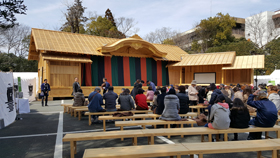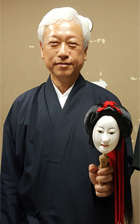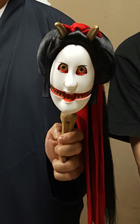

Featured Article of the Month
Bunraku – traditional puppet theatre for grown-ups?
By Ms Yow Wei Meng
|
“Puppet theatre? Yes, my 6-year old will be keen!”, “Puppets? That’s for kids!” – these are some common reactions I get when I mention bunraku (文楽) to my friends. Then I would go on to explain to them, with the help of videos available on internet, that Bunraku is a form of Japanese traditional theatre and that it is more for grown-ups or at least, teenagers, instead.
Why so? For one, this art form, also known as ningyo joruri (人形浄瑠璃), enacts plays using puppets (ningyo 人形) and the traditional narrative art called joruri (浄瑠璃) where a tayu (太夫), i.e. a narrator, tells a story with accompaniment by a musician playing the shamisen (三味線); and another reason is that the themes of the stories are not easily comprehensible by children. |
 Waiting for a Bunraku performance to commence on a make-shift stage outside the Ise Jingu Shrine in Mie, Japan. |
|
Take for example a well-known play The Love Suicides at Sonezaki1 (曽根崎心中) written by the famous playwright, Chikamatsu Monzaemon (A.D. 1653-1725 近松門左衛門), for the puppet theatre. It was based on a real event that happened in May 1703, where a man and a woman committed suicide together because circumstances prevented them from getting married even though they loved each other. Chikamatsu wrote the play soon after and it was first performed in June 1703. To understand why such plays may be difficult for children, just savour the lyrics2 below that are extracted from the play:
Farewell to this world, and to the night farewell. We who walk the road to death, to what should we be likened? To the frost by the road that leads to the graveyard, Vanishing with each step we take ahead: How sad is this dream of a dream! The beauty of such poetry narrated expressively by the tayu accompanied by the shamisen musician and intricate manipulation by the puppeteers – together, they form an artistic ensemble like no other! You have to listen to how a tayu narrates the story and delivers dialogues between the characters in the play in order to appreciate his artistry. He uses stylised vocal skills to differentiate the characters in dialogues, making sure the audience knows if the character is a man or woman, an adult or a child, for instance. Some say that this is similar to rakugo (落語) where the narrator enacts different characters in the story that he tells all by himself. What fascinates me most in bunraku is the puppetry. While puppets for minor roles are operated by one puppeteer, a puppet of a major role in a play is manipulated by three puppeteers or ningyo-zukai (人形遣い). A puppet’s head, its hands and legs are detachable from its torso. The lead puppeteer inserts his left hand through the back of the puppet’s costume to operate the puppet’s head and uses his right hand to operate the puppet’s right hand. The second puppeteer uses his left hand to operate the puppet’s left hand only while the third puppeteer uses both his hands to manipulate both legs of the puppet. All three puppeteers must move in a highly coordinated manner so as to make the movements of the puppet more lifelike. |
|
The faces of bunraku puppets are mostly expressionless. The audience are “led” to imagine a puppet laughing or crying, by the highly stylised manner in which the tayu delivers the characters’ dialogues. However, there is a handful of puppets that have built-in mechanisms allowing them to open and shut their mouths, raise their eyebrows, roll their eyes and to execute other more sophisticated movements.
One extremely interesting puppet head or kashira (首) is the type called gabu (ガブ) where, for instance, a pleasant-looking female character consumed with jealousy or rage, suddenly turns into an angry-looking demoness, with horns protruding from the top of the puppet’s head and showing fang-like teeth. I was fortunate to see, up close and personal, a gabu puppet head when my friend, veteran puppeteer, Yoshida Kanya (吉田勘彌), showed one to me a few years ago. |
  (Left) Veteran ningyo-zukai Yoshida Kanya holding a kashira (gabu). (Right) The kashira held by Yoshida Kanya transformed into a demoness. |
|
Bunraku has been inscribed in UNESCO’s Representative List of Intangible Cultural Heritage of Humanity and is usually performed in the National Bunraku Theatre in Osaka, Japan. Occasionally, bunraku is performed in Tokyo and other parts of Japan too.
I always try to read the bunraku libretto before watching a performance but in recent years, certain theatres are equipped with surtitles of the lyrics projected on the proscenium. Surtitles are a great help for the audience to understand the poetic and somewhat archaic language the tayu uses to narrate. When bunraku is performed in a country outside Japan, the organisers usually provide bilingual surtitles in Japanese and English. Don’t hesitate to catch a bunraku performance if one comes to town and enjoy this fascinatingly unique art form! |
|
Notes: 1 The Love Suicides at Sonezaki is the title translated into English by the late Professor Emeritus Donald Keene. 2 Donald Keene, Four Major Plays of Chikamatsu, Columbia University Press, 1961, p.51 |
About the Author
|
Ms Yow Wei Meng, a graduate of the National University of Singapore and the Nanyang Technological University, studied at Waseda University as a post-graduate research scholar specializing in Comparative Theatre – a comparison between Kabuki (歌舞伎) and Chinese Opera (or Xiqu 戏曲) under the late Professor Emeritus Kawatake Toshio (河竹登志夫). She is a veteran impresario for Xiqu in Singapore and being effectively trilingual in English, Chinese and Japanese, Ms Yow often translates surtitles for stage productions including but not limited to Xiqu as well as drama and has conducted talks on traditional performing arts at the library@Esplanade, the Japanese Association of Singapore and other locations. * All photos used in this article are provided by the authors / © Ms Yow Wei Meng |
|
Japan Creative Centre 4 Nassim Road, Singapore 258372 +65 6737 0434 / jcc@sn.mofa.go.jp http://www.sg.emb-japan.go.jp/JCC Nearest parking at Orchard Hotel & Delphi Orchard |
 |